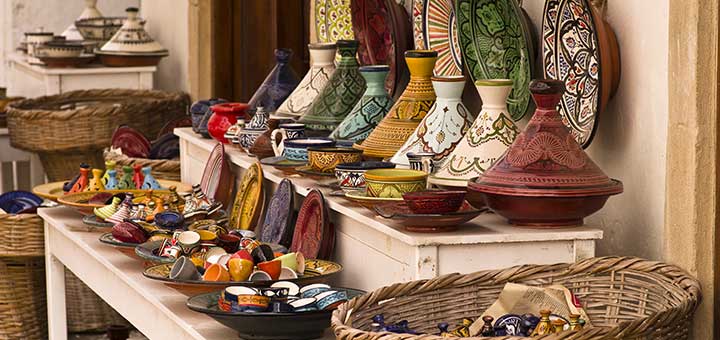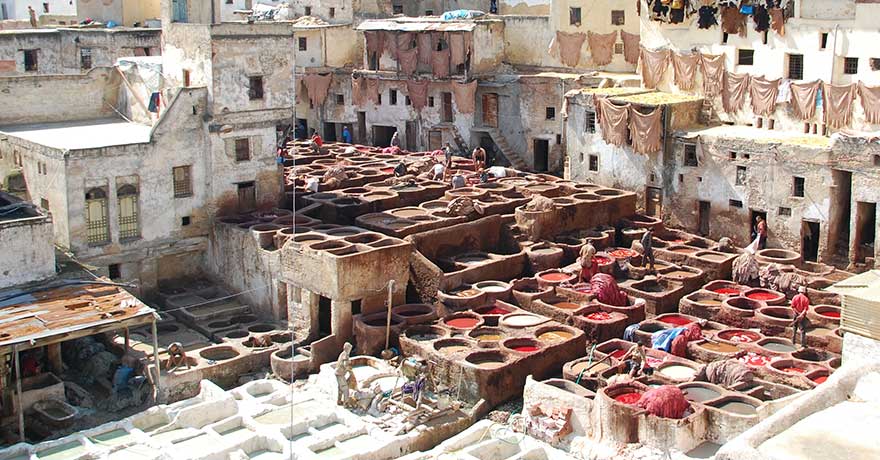Morocco Travel Guide

When it comes to Morocco, the country certainly attracts a lot of mystical charm and enigmatic ambience. Looking right out of the pages of an oriental fairytale, Morocco holds an enduring fascination. Despite the fact that Morocco is not that far away from Europe at all (only an hour ride on a ferry from Spain), the country still appears to be very different and enigmatic, with a deep-rooted Islamic culture and quirky traditions. The years of French and Spanish colonial rule have left their footprint and impact on the local culture, history and lifestyle, however, Morocco still possesses a lot of distinctive charm and culture you cannot meet and experience anywhere in the world.
The modern and cosmopolitan cities like Rabat and Casablanca are contrasting cities and places like Fez that look and feel like preserving the medieval Arab culture in a very sensible way. To add up to the colouring and uniqueness of the country, the mountains of the Atlas and the Rif are still a home to tribes, the most popular out of them being the Berber population. And if all this mix of cultures, people and places is not enough for you, you will be surprised to find out that Morocco is even more diverse, with an extraordinary physical make-up – from the Mediterranean coast, through four magnificent mountain ranges, to the endless golden sands of Sahara. In fact, there is plenty to do, experience and see, when in Morocco and the country is catering for the needs, requirements and preferences of every tourist and traveller from around the world.

Casablanca
Across the majority of the country, the colonial French and Spanish influence is still present and easy to sense in people’s everyday life and the local culture. The so-called Spanish zone of Morocco includes Tetouan and the Rif, the Mediterranean and the northern Atlantic coasts, Sidi Ifni, the Tarfaja Strip, Western Sahara. On the other hand, the French colonial culture is dominant in the areas of the plains and the main cities of Fez, Marrakesh, Casablanca and Rabat, the Atlas mountain range. Interweaving with all this colourful mix of cultures, lifestyles, influences and languages, the deep-rooted Arabic culture is present everywhere around. However, the main vibe of the country that the first-time visitor will feel is the French effect, which is predominantly present in the Europeanised big cities and firmly imposing the language. French is spoken today by all educated Moroccans (usually along with Moroccan Arabic and one of the three Berber languages).

Rabat
A blend of modern and traditional, a number of distinctive cultures, an exotic and familiar, diversity of landscapes and cityscapes, all the contrasts surrounding, visiting Morocco should be definitely a part of your bucket list, a dream you make come true, a truly rewarding and special experience you will enjoy for sure. In addition, the country is just a heaven for the independent traveller, with plenty to do, see and experience. Make sure to allow yourself enough time to enjoy and try at least a big part of all the activities the country is offering – hiking, relaxing, wandering around, enjoying the amazing cuisine and the popular refreshing mint tea and much much more!

Marrakesh
Keep in mind that despite the beautiful landscapes and cityscapes surrounding, Morocco is still a country of extreme poverty, and the contrast could be hard to handle at time, so have respect to Morocco and its people and be grateful for your privilege to be a tourist and have the opportunity to visit such an amazing and enigmatic country. However, Morocco is overall a safe and politically stable place, so there is nothing to worry when visiting the country. Finally, Morocco has an admiringly strong and powerful tradition in hospitability, generosity and openness, so by the end of the day, no matter where you go and what you see, your impressions will be always overwhelmingly positive. Morocco is certainly not a one-time-visit country because it will make you go back again and again!
When to go?
In case we are talking about climate as an essential thing to consider when planning your visit to Morocco if you want to explore the desert and the south part of the country, make sure to avoid midsummer. Most of the summer days are way too hot for a convenient and enjoyable wandering and strolling around. Public transport is definitely not a comfortable place on the hottest days too. July and August are certainly the months with the majority of the hottest days, so if this is the only time of the year available to travel and visit the country, make sure to choose the coast and spend a really pleasurable and relaxing summer holiday there.
Spring in Morocco comes around in April or May and it is, for sure, the best time of the year for visiting Morocco in general. The climate in the south and the mountains is summery, but bearable in the south, while the coasts and the rest of the country are very sunny and extremely pleasant to stay in and enjoy. Winter in Morocco offers the perfect sunny day in the south parts, but the closer you are to the desert, the colder the nights are. In case you are planning to hike the mountains of the country, the most recommended time is from April to October. The Islamic religious calendar is the other aspect that will influence your travel plans the most aside from the weather and climate conditions. The aspect you have to pay the most attention to is the period of Ramadan – a whole month of daytime fasting, which can cause some difficulties, because many places and services are not working during this period, especially the public transport.
Where to go?
If you are wondering where to start your travel to and through Morocco, the most important thing to start with is the fact that geographically the country is divided into four zones – the coasts (Mediterranean and Atlantic), which are perfect for the ultimate summer resort holiday, the Rif and Atlas mountains, which are, pretty much obviously, perfect for hiking and enjoying beautiful landscapes, the great cities in the country, which offer plenty of activities and things to see and explore, and the oases and desert of Sahara, which are much recommended for a more unique and exciting travel experience. Two to three weeks are enough to cover all of the zones, however, you would be able to do that more briefly. In case you could allow yourself and you have the desire to spend two to three months in Morocco, this is the perfect period of time to pay attention to all details and explore Morocco in depth.

Atlas Mountains
In general, if you want to start with the coast, it is best enjoyed in the north at Tangier, magnetising with its old international port status and charm, Asilah and Larache. Then comes the best places in the south – El Jadida, Essaouira, and the popular resort Sidi Ifni. Agadir is probably the most popular summer holiday resort in Morocco, offering the ultimate holiday experience worth experiencing.
The inland of Morocco is offering plenty of must-experience too, a home to the main and most popular cities of Morocco. The cities standing out the most are the medieval atmospheric Fez and the capital Marrakesh. Both cities have been capitals of various dynasties, because of that are homes to a lot of different and diverse cultures, lifestyles, histories, people, languages, architectural styles, because of that very unique in the Arab world. If you are into a more historical experience, Fez is definitely the highlight.

Fez
While the north of the country is more frenetic, the south is much easier and relaxing. The mountain ranges offer truly a breath-taking beauty and an amazing experience for enthusiastic hikers. The most popular spot for hiking in the High Atlas, especially around North Africa’s highest mountain Jebel Toubkal, with plenty of mule paths and mud-brick villages dotted around. Summer treks are recommended for both professional hikers and enthusiastic amateurs.
The great southern routes beyond the Atlas mountains range will lead you to one of the most distinctive and interesting areas of Morocco – the oases of the pre-Sahara. The majority of the main routes in this area can be travelled by bus, while the minor ones are accessed by car (you can rent one) or a local taxi. The real remote ones are perfect for 4WD vehicles, which adds up to the whole experience, but you can also get a lift on the local caminos (lorries). The classic image of the Arab world is reflected by the oases around Tinghir, Zagora, Erfoud, Tata, Figuig. The architecture there is very distinctive and interesting, so the oases are your chance to see the quirky and fabulous pise kasbahs and ksour.



